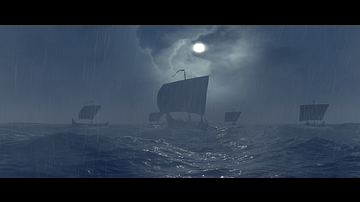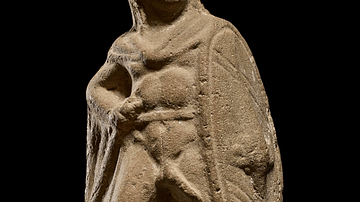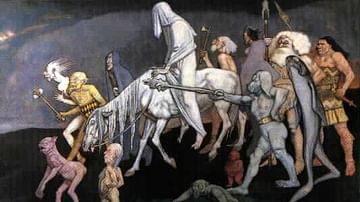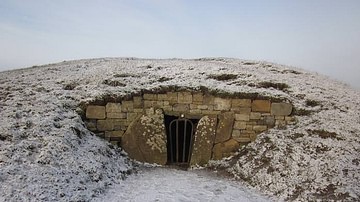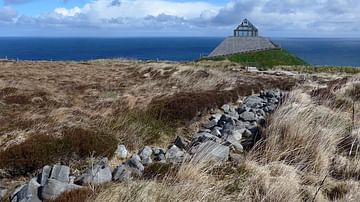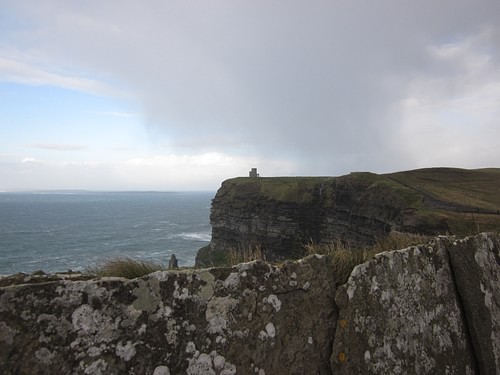
Ireland is an island country located in the North Atlantic, bounded by the North Channel, the Irish Sea, and St. George's Channel. It is known as Eire in the Gaelic language, which comes from the old Irish Eriu, the name of a daughter of the mother goddess Ernmas of the Tuatha De Danaan, the mystical pre-Celtic race of Ireland.
Legend tells that, when the Milesians invaded Ireland to conquer the Tuatha De Danaan, Eriu and her sisters, Banba and Fodla, asked that they name the island after them. Eriu became the most commonly used name, while Banba and Fodla were used poetically as one might a nickname.
The name Eire is also thought to derive from the Erainn (whose name derives from the same root), the chief tribe of the region of Munster in the south-west mentioned in the Greek historian Ptolemy's Geography (2nd century CE). The Erainn were also called the Iverni by Ptolemy, which would give later Romans their name for Ireland: Hibernia. Ireland is the third largest European island (after Great Britain and Iceland) and is presently divided politically between the Republic of Ireland, a sovereign state, and Northern Island, which is a part of Great Britain.
The Republic of Ireland is generally referred to simply as 'Ireland'. Eire is usually translated as 'abundant land' or 'plentiful land', either in reference to the goddess who was thought to inhabit the region and bless it with fertility or to the tribe who Ptolemy claimed possessed rich lands.
Early Human Habitation
Ireland was uninhabited by people for a much longer time than many other countries. Historian Jonathan Bardon comments, "It is an arresting thought that human beings had been living in Australia for 40,000 years before the very first people came to live in Ireland" (1). Bardon and others attribute this to the Midlandian Ice Age whose vast sheets of ice only began melting in Ireland c. 15,000 BCE.
The land was then home to only plants and animals that had crossed over from the European mainland on land masses that were submerged when the glacial ice sheets melted. Ireland and Britain were both separated from the European continent at about this time (c. 12,000 BCE). The first people arrived in Ireland between 7,000-6,500 BCE at Coleraine in the far north. The Mount Sandel Mesolithic Site, discovered at Coleraine in 1973 CE, is the oldest archaeological site in Ireland.
Mesolithic Ireland's inhabitants were hunter-gatherers who traveled in small bands from region to region, building villages of wooden huts with domed roofing of bark and animal skin. These huts were communal lodges for extended families with a single basin-shaped fire pit in the center and a round opening in the roof for ventilation of smoke. They used flint to form axes, knives, scrapers, harpoon blades, and arrowheads.
Based upon archaeological evidence they seem to have also participated in rituals involving painting both themselves and ceremonial objects. Over time, these hunter-gatherers gradually shifted to an agrarian lifestyle of farming. Bardon writes, "From around 4000 BC a dramatic transformation of the Irish economy began. Until then a small scattered population had lived exclusively by foraging, trapping, and hunting. Now they began to clear the land of trees to create pastures for domestic stock and cultivation ridges for growing cereals" (4).
The Ceide Fields in County Mayo near Ballycastle date from this time and are the oldest known farming fields (known as a field system) in the world. The Ceide Fields were discovered by the local teacher Patrick Caulfield who was harvesting peat from a bog for his hearth. He noted configurations of carefully placed stones beneath the layer of peat bog, which seemed deliberate in design.
His discovery led to the excavation of the site many years later that uncovered a Neolithic settlement of houses, field systems, walls, and tombs. The Neolithic farmers cleared more and more land, clearing the forests and building more substantial homes and villages. Bardon notes how, based upon archaeological evidence, it is certain that "a dense forest canopy [once] covered the island so completely that a red squirrel could travel from Ireland's most northerly point, Malin Head, to Mizen Head in Co. Cork [the southern-most point] without ever having to touch the ground" but now this dramatically changed as farming communities flourished and more land was cleared for crops.
The wooden huts of the Mesolithic era gave way to houses made of wattle-and-daub with thatched roofs, such as the one found at Ballynagilly, County Tyrone, in 1969 CE, a home considered the oldest Neolithic house found in Britain or Ireland, dated to c. 3700 BCE. Even more elaborate homes have been discovered from shortly after this date, including one in County Limerick, at Tankardstown, "built entirely of oak planking with corner posts and external roof supports" (Bardon, 5). The historian Roger Chauvire writes, "In the beginning, Ireland was virgin and empty land" and had remained so for the 3,000 or so years the hunter-gatherers had roamed through the forests, but that time had now passed (20). The land was tamed and the people settled into stable communities.
The Mythical Origins
While this account of Ireland's past is presently the accepted early history of Ireland, it was not always so. 'History' is a word whose meaning changes according to the accepted beliefs of those who write it. For hundreds of years, a different series of events was accepted as history, which are now referred to as 'mythical origins'. This history was unfolded in the book known as Lebor Gabala Erenn (The Book of the Taking of Ireland or The Book of Invasions), written in the late 11th/early 12th century CE.
This story recounts early Irish history as beginning before the Great Flood when Cessair, daughter of one of Noah's sons (Bith, who is not mentioned in the biblical tale in Genesis), is denied a place on the Ark and flees to Ireland. She arrives with three men and 49 women who are all drowned with her in the Flood save one man, Fintan, who is transformed into various animals until becoming a man again and telling his tale. The second group of immigrants was led by Partholan, son of Sera, son of Japheth (one of Noah's sons in the Bible), following the Great Flood.
They came from somewhere in the east and established a colony that was destroyed by disease, all of them dying in the course of a week. Partholan was followed by Nemed, son of Agnoman, who also traced his ancestry through Japheth back to Noah. They came from Scythia and settled in Ireland but were set upon by the Fomorians, savage sea pirates, under their king Balor the Cyclop and fled the country.
Two hundred years passed in which Ireland was uninhabited, and then the Fir Bolg, a group of Nemedians from Greece, took the land and built homes and forts. They were attacked by the Tuatha De Danann (children of the goddess Dana) who were masters of magical arts and formidable adversaries. The Fir Bolg were defeated by the Tuatha De Danann at the Battle of Moytura and forced to serve them. There then came another son of Japheth, son of Noah, Fenius, who came from the Tower of Babel where he combined only the best elements of all the languages of the world he'd heard there to create the Irish speech, and it was his descendent, Goidil (pronounced 'Gaydel') who gave his name to the Gaels and their language: Gaelic.
Goidil's mother was Scotta, daughter of a pharaoh of Egypt, who would found Scotland (though the founder may have been another woman of the same name, her sister), and his grandson was Eber Scott who conquered all of Spain. Scott's son was Miledh (also known as Milesius), who ruled after him. Around the time of the birth of Alexander the Great (an event already famous for signs and wonders in the heavens), Miledh looked out from the tower of his castle and saw Ireland floating on the horizon. He sent his three sons - Meremon, Heber, and Ir - from Spain and they conquered the Tuatha De Danann, driving them to a place between worlds where they remain to this day.
The three daughters of the goddess Ernmas of the Tuatha De Danaan - Eriu, Banba, and Fodla - asked the Milesians to name the land after them, and so it was. The Milesian invasion was considered the final colonization of Ireland, which subdued the land and established the civilization and culture as the later writers of these tales knew it.
Commenting on this history, Roger Chauvire writes:
These nursery tales have more than a folklore value. They were made to synchronize with the biblical computation, and integrated into a so-called universal history round about the twelfth century by the authors of the Book of Invasions; they were accepted as true all through the Middle Ages, and even later, and this is where their importance lies. There was no great princely house which did not allege, by means of some juggling on the part of its genealogies, that it went back to Milesian times, and on this it would base its claims [to rule]. (20-21)
It is unknown how the people of the Neolithic Age viewed their history or what their mythology may have been since they left no written record. The "mythological origins" history of Ireland was written long after by Christian scribes drawing on biblical stories to create a national history. Back in the Neolithic Age, the people of Ireland might have been far too busy establishing farms and villages and making a living to worry about their past history, or perhaps not. While they wrote nothing, they did leave a story behind in the great megalithic structures one finds all across the country in grander or more modest forms, and few are so dramatic as those of the Bru na Boinne Neolithic complex in County Meath.
The Megaliths
Evidence of a pre-literate culture who told their stories through stonework can be seen throughout Ireland. Exactly what these stories are is still a mystery, however. The great megalithic monument known as Newgrange was constructed c. 3200 BCE, and the megalithic passage tombs of Knowth and then Dowth followed soon after. Loughcrew passage tomb, also in Meath, dates from between 3500-3300 BCE. The Carrowkeel passage tombs in County Sligo date from c. 3400 BCE, while the megalithic tombs of Carrowmore (also in Sligo) date from even earlier (3700 BCE), and the Poulnabrone dolmen (a megalithic passage tomb in County Clare) to even earlier (4200 BCE).
All these megaliths and majestic mounds (each one older than Stonehenge or the pyramids of Giza) give evidence of a deeply held belief system which may have honored ancestors, great deeds, heroes, chieftains, and deities, but there is no way of knowing because nothing was recorded. The swirling designs and other engravings on stones at sites like Newgrange, if they mean anything beyond decoration, have shed no light on the subject.
There is no doubt that Newgrange was constructed for a very specific ritualistic purpose. Every December, in the days leading up to and away from the winter solstice, the rising sun sends a single beam directly through a portal above the front passage entrance that illuminates the inner chamber, focusing on one single niche in the back wall. As with the other monuments mentioned, there have been many theories advanced as to the purpose Newgrange served but none are conclusive, nor can they be.
The Poulnabrone dolmen, with its massive slanting capstone, seems to have been constructed at an angle for a specific purpose, possibly to ease the souls of the deceased in their passage to the Underworld or ward off unwanted visitors from the other side, but no one really knows why the capstone was slanted. Dr. Carleton Jones, who excavated the site, claims it may have been a 'prehistoric billboard' as well as a tomb, writing, "As a traveler entered the Burren from the north, the impressive bulk of Poulnabrone would leave no doubt in their mind that they were entering the Burren tribe's territory" (1).
Still, this 'billboard' theory does not seem to apply to every dolmen in the country. There are almost 200 dolmens throughout Ireland, all with slanting capstones, and all seem to have been used as tombs but not as `billboards'. Among the largest is the Kilclooney dolmen in County Donegal (c. 3500 BCE), which stands six feet high with a capstone 13 feet long and 20 feet across. All of these, of course, were constructed without cement, cranes, or metal tools.
The Bronze Age & The Celts
Metalworking developed long after the megaliths were built. It was already a practiced craft by 2000 BCE, probably introduced or discovered c. 2500 BCE. Bronze and copper replaced the stone ornaments and weaponry of the earlier age, and advances in technology increased rapidly. The wheel was introduced at around the same time as techniques for brewing alcohol c. 2200 BCE. Farming implements were improved and more land was cleared and cultivated.
The Giant's Ring, a henge monument in present-day Ballynahatty near Belfast, was constructed about this time (c. 2700 BCE) and regularly used for rituals (probably religious, and no doubt astronomical, though the details are unknown). As in Scotland, at roughly the same time (2500 BCE), a new wave of immigrants introduced flat-bottomed beakers and sophisticated earthenware pottery. These beakers have been found throughout Ireland in such great quantity that these unknown immigrants are referred to as "Beaker People" by archaeologists (as they are also in Scotland).
The Beaker People may be the mysterious builders of circular hill forts found throughout Ireland such as the Mooghaun Hill Fort in County Clare where, in 1854 CE, the largest hoard of gold found anywhere outside of the Mediterranean was discovered. The "Great Clare Find" as it was called dated to 800 BCE, and its creation is often attributed to the Celts rather than the Beaker People, but this is disputed.
The Bronze Age merged into the Iron Age with the arrival of the Celts sometime between 500-300 BCE, possibly earlier. This influx used to be regarded as "the Celtic invasion", but that theory has now been discarded as it seems far more likely that the Celts and the indigenous people of Ireland were engaged in trade which led to cultural diffusion and Celtic assimilation. Bardon writes:
When did the Celts come to Ireland? A clear answer cannot be given because they do not seem to have formed a distinct race. Celtic civilisation may have been created by a people in central Europe, but it was primarily a culture - a language and a way of life - spread from one people to another. Archaeologists have searched in vain for evidence of dramatic invasions of Ireland, and they now prefer to think of a steady infiltration from Britain and the European mainland over the centuries. (12)
According to historian Helen Litton, the Celts originated in central and east-central Europe in the Early Iron Age, and "they seem to represent a coming together of various groups, during the Bronze Age, who gradually developed a single culture around the discovery and use of iron" (19-20). When the Celts arrived in Ireland, however gradually or swiftly, they brought the knowledge of iron working with them. They also brought conquest as they came in their war chariots fully armed with their "swords as long as the javelins of other peoples and their javelins with points longer than swords", in the words of the Greek historian Diodorus Siculus. They quickly subdued and assimilated the inhabitants of the land to form the Gaelic culture.
St. Patrick & the Rise of Literacy
The Celts ordered their society in Ireland into a hierarchy of warriors and Druids at the top and everyone else beneath them. They built great fortresses, adorned themselves with gold brooches and cloaks, and told epic tales which would not be written down until hundreds of years later, such as The Cattleraid of Cooley, the great Irish epic, featuring the hero Cuchulainn and the great Queen Maeve, the Fenian Cycle, the deeds of great kings like Cormac MacArt, the knights of the Red Branch from the Ulster Cycle, and epic legends like The Pursuit of Diarmund and Grainne.
Literacy came to Ireland with the Christian missionary Palladius and others such as Ailbe, Declan, Ibar, and Ciaran who followed him, as well as the better known St. Patrick in the 5th century CE. Palladius and the others established Christian communities that placed a premium on literacy and became centres of learning, but they were not as successful as the former slave who escaped from captivity in Ireland to return a bishop and change the nation: St. Patrick.
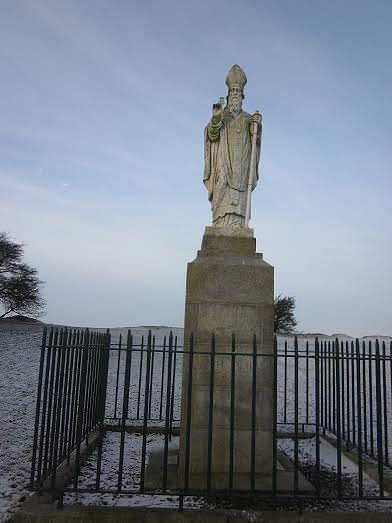
Patrick (c. 5th century CE) was a Roman citizen who was captured by pirates from Roman Britain and sold into slavery in Ireland. After six years he escaped, following a vision in a dream in which God directed him to leave by ship. He returned to Britain and his family but again was summoned in a dream to leave his land and return to Ireland to preach the gospel. Patrick did far more than convert pagan Ireland to Christianity; he popularized the faith, carefully integrating it with what he knew of Celtic mythology and Irish lore so that it was more easily assimilated.
He is said to have announced the arrival of Christianity in the country with a great bonfire on the Hill of Slane, just opposite the Hill of Tara, in 432 or 433 CE, defying the edict of the High King Laoghaire who had prohibited any fires that night save the sacred flame of the druids on Tara to celebrate the festival of Ostara. The faith St. Patrick announced that night would change Ireland in many ways, perhaps most importantly in the area of literacy. In spreading the Christian message through the land, St. Patrick planted the seeds of Christian communities, which became seats of learning and centers of knowledge.
The High Kings & the Law
The Hill of Tara in County Meath stands at an elevation of 646 feet (197 metres) and, at the summit, rises the Lia Fail, the stone of destiny where the High Kings of Ireland were inaugurated. Legend tells how, after the Milesians defeated the Tuatha De Danaan, Ireland was divided between the two victorious brothers Eber and Eremon; Eremon taking the north and Eber the south. They lived in peace until Eber's wife desired the most beautiful hill in the land, Tara, which was in Eremon's territory and Eremon's wife, Tea, refused her.
The two women drew their husbands into the argument, and they went to war. Eber was killed and Eremon took his lands. Tea also died at this time and gave her name to the hill she had defended and where she was buried. One interpretation of 'Tara' is a corruption of Tea-Mur, Tea's Tomb. The Hill of Tara was thenceforth regarded with great respect for this reason, as well as for the belief that it was imbued with magic by the Tuatha De Danaan, who dwelt in the ground and hollows of the hill and who had brought the Lia Fail to the land centuries before.
These beliefs continued to be observed after the Celts arrived and their kings were crowned at the Lia Fail in accordance with custom. Among the early prehistoric kings was the legendary Conn Cetchathatch (Conn of the Hundred Battles) whose grandson was Cormac MacArt the law giver. The Brehon Laws (also known as the Brehon Codes and Fenechas) are the earliest laws of Ireland and were written by MacArt at some point during his reign (c.227-266 CE).
The name derives from Brehon, which means lawgiver, and these laws were interpreted by the Brithem (judges). They are considered among the most advanced and equitable laws ever written (including ancient law codes such as the Code of Ur-Nammu or Hammurabi's Code from ancient Mesopotamia) and, according to historian Loretta Wilson, "covered almost every relationship and every fine shade of relationship, social and moral, between man and man" (1).
The laws provided justice for all, no matter one's social standing, and maintained the independence and dignity of women, which had long been observed in Ireland. Historian Lloyd Duhaime, writing on the Brehon Laws, notes that "women were held on an equal footing as men and eligible for the highest professions including as warriors, priestesses and judges . . . . At marriage, women were partners with their husbands, and not the property of the latter" (2).
Cormac MacArt was considered one of the greatest, if not the greatest, king of ancient Ireland and, besides being known for his laws, initiated building projects as great as the halls and forts of Tara and as modest as riverside mills. His Brehon Laws would later be revised and codified by St. Patrick who maintained the humane aspect of them and upheld the rights of women in society.
The achievements of St. Patrick and Cormac MacArt, like much of early Irish history, are blended with myth, and so it is with MacArt's descendants, the Ui Neill, the dynasty most prominent in Ireland for centuries. The Ui Neill were descended from Niall Noigiallach (better known as Niall of the Nine Hostages) who, as his name indicates, was a powerful enough king to have held one hostage each from the five provinces of Ireland and one each from the Britons, the Franks, the Saxons, and the Scots.
The oldest monument at the Hill of Tara is the Mound of the Hostages, a passage tomb dating to c. 3000 BCE. The name comes from the later practice of kings and chieftains exchanging hostages at the site. The more hostages one held to ensure good behavior of would-be rivals, the more powerful and secure the ruler.
The Viking age in Ireland
Like the legendary Eber and Eremon, the Ui Neill divided the country between them with the northern Ui Neill and the southern Ui Neill. The Ui Neill defended the land against the ever increasing Viking raids along the coasts, built forts and towers, and developed the land. The Viking Age in Ireland began with the first recorded raid in 795 CE off the coast of Antrim and ended in 1014 CE with the Viking defeat by the great High King of Ireland Brian Boru (941-1014 CE) at The Battle of Clontarf. Although Boru is famously known as the king who drove the Vikings from Ireland, this is not so. The Vikings had established a number of permanent settlements, most notably Dublin, and continued to play a part in Ireland's history following Clontarf.
The legend of Boru driving the Vikings from the land is rooted in his victory over the combined forces of the Vikings and Boru's Irish enemies at Clontarf, after which Viking power was broken and Irish monarchies, like the Ui Neill, grew in strength. They had reigned before Boru came to power and, after his death at The Battle of Clontarf, the Ui Neill resumed control of the land but their power was diminished. Following the Norman Invasion of 1169 CE and England's King Henry II's domination of Ireland in 1171 CE, their power, like the other nobles of Ireland, was weakened further.
English rule in Ireland grew steadily more oppressive by the decade, if not by the year, and by 1368 CE, the Brehon Laws were outlawed under the Statute of Kilkenny. The once prestigious clans like the Ui Neill stood their ground as well as they could until they were largely removed in the 17th century CE through the English policy known as the Plantation of Ulster.
Under this policy, half a million acres of some of the best land was taken from Gaelic Catholic chieftains and their families following Hugh O'Neill's defeat at the Battle of Kinsale in 1601 CE and the Flight of the Earls in 1607 CE. The Plantation policy sought to replace Irish Catholics on the land with English Protestants, and it succeeded. Along with the other rules, laws, and strictures imposed on the Irish, it would not be until after 1921 CE that the people of Ireland would regain a measure of the freedom and autonomy they had known prior to the Norman Invasion.
The Legacy of Ireland
In spite of the severity of English measures, the Irish continued to endure and thrive through the centuries. They found ways to preserve their language, law, and culture, which had been outlawed and driven underground, and they owed this success to the foundation laid centuries before by St. Patrick and the early Christian missionaries.
Literacy flourished in the monastic centers of Ireland eventually producing masterpieces of sacred art such as the illuminated manuscript the Book of Kells by c. 800 CE. Great monasteries and communities such as Clanmacnoise and Glendalough were established by the middle of the 6th century CE, only a little over a hundred years after St. Patrick had arrived. The monasteries of Ireland would do more than just encourage literacy in the country; they would save the heritage of western civilization.
The Western Roman Empire fell 4 September 476 CE when the Emperor Romulus Augustus was deposed by the Germanic king Odoacer. The empire had been in turmoil, to greater or lesser degrees, since the Crisis of the Third Century (235-284 CE) and was divided into eastern and western empires in 285 CE. The stability that Rome had offered for centuries was gone and religious factions added to the chaos of the barbarian invasions to threaten the great libraries of the ancient world. St. Patrick is thought to have begun his missionary work in Ireland c. 432 CE and, not long after, monks were copying any book they could find. Thomas Cahill, author of How The Irish Saved Civilization, writes:
The Irish, who were just learning to read and write, took up the great labor of copying all of western literature - everything they could lay their hands on. These scribes then served as conduits through which the Greco-Roman and Judeo-Christian cultures were transmitted to the tribes of Europe, newly settled amid the rubble and ruined vineyards of the civilization they had overwhelmed. Without this Service of the Scribes, everything that happened subsequently would have been unthinkable. Without the Mission of the Irish Monks, who single-handedly re-founded European civilization throughout the continent in the bays and valleys of their exile, the world that came after them would have been an entirely different one - a world without books. (4)
The claim that the Irish monks saved civilization may seem like an overstatement, but the historical record proves otherwise. Although Agricola initiated plans to invade Ireland, and archaeological finds have unearthed evidence of Roman habitation (in Roman coins, graves, and tools), the invasion never took place. Ireland was left alone by the empire and was largely unaffected by its fall. In the safety of the island, within the walls of their communities, the monks gathered and safeguarded the books that were neglected or destroyed on the mainland, preserving the past for the future.
